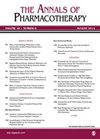接受地诺单抗治疗的实体恶性肿瘤骨转移患者的低镁血症发生率和风险因素:回顾性病历分析
IF 2.3
4区 医学
Q3 PHARMACOLOGY & PHARMACY
引用次数: 0
摘要
背景:低镁血症与癌症患者的不良临床预后有关。接受地诺单抗(Dmab)以预防骨骼相关事件的实体恶性肿瘤骨转移患者通常会同时接受抗肿瘤药物治疗。目的:研究低镁血症的发生率和潜在风险因素以及监测血清镁(Mg)水平的最佳频率。方法:回顾性病历审查确定了2013年1月至2024年2月期间在洛马琳达大学癌症中心接受Dmab治疗的实体恶性肿瘤骨转移患者。低镁血症的发生率是根据低镁血症患者的人数和研究中患者的总人数确定的。单变量和多变量逻辑回归分析确定了低镁血症的风险因素。结果:19%的患者(29/153)出现了低镁血症,其中大部分患者同时服用了低镁血症发生率≥15%的抗肿瘤药物(高镁抗肿瘤药物)或有低镁血症病例或发生率记录的非抗肿瘤药物(低镁非抗肿瘤药物)。多变量分析显示,使用高血镁抗肿瘤药物会增加患低镁血症的几率(几率比 [OR]:174.93,95% 置信区间 [CI]:12.82至387.43,P< 0.001);低镁非抗肿瘤药物加高镁抗肿瘤药物(OR:210.09,95% CI:11.80至3740.12,P< 0.001);Dmab给药前Mg水平≤0.85(OR:16.79,95% CI:2.30~122.41,P = 0.005).结论与相关性:本研究描述了实体恶性肿瘤和转移性骨病患者接受Dmab治疗后低镁血症的发生率和潜在风险因素。本研究结果为临床提供了更多关于低镁血症潜在风险因素的见解,以及对高危患者进行更频繁的血清镁水平监测的必要性。未来还需要进行前瞻性研究,以确定监测这类患者血清镁水平最合适的确切频率。本文章由计算机程序翻译,如有差异,请以英文原文为准。
Incidence and Risk Factors of Hypomagnesemia in Patients With Bone Metastasis From Solid Malignancies Treated With Denosumab: A Retrospective Chart Review
Background:Hypomagnesemia is associated with poor clinical outcomes in cancer patients. Patients with bone metastasis from solid malignancies receiving denosumab (Dmab) to prevent skeletal-related events often receive concurrent antineoplastic agents for cancer treatment. The incidence and risk factors of hypomagnesemia in patients receiving Dmab and the optimal frequency of monitoring serum magnesium (Mg) levels have not been studied in these patient populations.Objective:The objective is to investigate the incidence and potential risk factors of hypomagnesemia and the optimal frequency of monitoring serum Mg levels.Methods:A retrospective chart review identified patients with solid malignancies with bone metastases treated with Dmab at the Loma Linda University Cancer Center between January 2013 and February 2024. The incidence of hypomagnesemia was determined using the number of patients with hypomagnesemia and the total number of patients in the study. Univariate and multivariate logistic regression analyses identified risk factors for hypomagnesemia.Results:Hypomagnesemia was observed in 19% (29/153) of patients, the majority of whom were on concurrent antineoplastic agents with ≥15% hypomagnesemia incidence (high-hypomagnesemic antineoplastics) or nonantineoplastic drugs with documented cases or incidence of hypomagnesemia (hypomagnesemic nonantineoplastics) in addition to high-hypomagnesemic antineoplastics. Multivariate analysis showed increased odds of developing hypomagnesemia with high-hypomagnesemic antineoplastics (odds ratio [OR]: 174.93, 95% confidence interval [CI]: 12.82 to 387.43, P < 0.001); hypomagnesemic nonantineoplastics plus high-hypomagnesemic antineoplastics (OR: 210.09, 95% CI: 11.80 to 3740.12, P < 0.001); and Mg level ≤ 0.85 prior to Dmab administration (OR: 16.79, 95% CI: 2.30 to 122.41, P = 0.005).Conclusion and relevance:This study describes the incidence and potential risk factors for hypomagnesemia in patients with solid malignancies and metastatic bone disease treated with Dmab. This study’s findings provide additional clinical insight into potential risk factors for hypomagnesemia and the need for more frequent serum Mg level monitoring of at-risk patients. Future prospective studies are needed to determine the exact frequencies most appropriate in monitoring serum Mg levels in this group of patients.
求助全文
通过发布文献求助,成功后即可免费获取论文全文。
去求助
来源期刊
CiteScore
5.70
自引率
0.00%
发文量
166
审稿时长
3-8 weeks
期刊介绍:
Annals of Pharmacotherapy (AOP) is a peer-reviewed journal that advances pharmacotherapy throughout the world by publishing high-quality research and review articles to achieve the most desired health outcomes.The articles provide cutting-edge information about the most efficient, safe and cost-effective pharmacotherapy for the treatment and prevention of various illnesses. This journal is a member of the Committee on Publication Ethics (COPE). Average time from submission to first decision: 14 days

 求助内容:
求助内容: 应助结果提醒方式:
应助结果提醒方式:


